Lingpeng Kong
Dream-VL & Dream-VLA: Open Vision-Language and Vision-Language-Action Models with Diffusion Language Model Backbone
Dec 27, 2025Abstract:While autoregressive Large Vision-Language Models (VLMs) have achieved remarkable success, their sequential generation often limits their efficacy in complex visual planning and dynamic robotic control. In this work, we investigate the potential of constructing Vision-Language Models upon diffusion-based large language models (dLLMs) to overcome these limitations. We introduce Dream-VL, an open diffusion-based VLM (dVLM) that achieves state-of-the-art performance among previous dVLMs. Dream-VL is comparable to top-tier AR-based VLMs trained on open data on various benchmarks but exhibits superior potential when applied to visual planning tasks. Building upon Dream-VL, we introduce Dream-VLA, a dLLM-based Vision-Language-Action model (dVLA) developed through continuous pre-training on open robotic datasets. We demonstrate that the natively bidirectional nature of this diffusion backbone serves as a superior foundation for VLA tasks, inherently suited for action chunking and parallel generation, leading to significantly faster convergence in downstream fine-tuning. Dream-VLA achieves top-tier performance of 97.2% average success rate on LIBERO, 71.4% overall average on SimplerEnv-Bridge, and 60.5% overall average on SimplerEnv-Fractal, surpassing leading models such as $π_0$ and GR00T-N1. We also validate that dVLMs surpass AR baselines on downstream tasks across different training objectives. We release both Dream-VL and Dream-VLA to facilitate further research in the community.
DoPE: Denoising Rotary Position Embedding
Nov 12, 2025Abstract:Rotary Position Embedding (RoPE) in Transformer models has inherent limits that weaken length extrapolation. We reinterpret the attention map with positional encoding as a noisy feature map, and propose Denoising Positional Encoding (DoPE), a training-free method based on truncated matrix entropy to detect outlier frequency bands in the feature map. Leveraging the noise characteristics of the feature map, we further reparameterize it with a parameter-free Gaussian distribution to achieve robust extrapolation. Our method theoretically reveals the underlying cause of the attention sink phenomenon and its connection to truncated matrix entropy. Experiments on needle-in-a-haystack and many-shot in-context learning tasks demonstrate that DoPE significantly improves retrieval accuracy and reasoning stability across extended contexts (up to 64K tokens). The results show that the denoising strategy for positional embeddings effectively mitigates attention sinks and restores balanced attention patterns, providing a simple yet powerful solution for improving length generalization. Our project page is Project: https://The-physical-picture-of-LLMs.github.io
DynaAct: Large Language Model Reasoning with Dynamic Action Spaces
Nov 11, 2025Abstract:In modern sequential decision-making systems, the construction of an optimal candidate action space is critical to efficient inference. However, existing approaches either rely on manually defined action spaces that lack scalability or utilize unstructured spaces that render exhaustive search computationally prohibitive. In this paper, we propose a novel framework named \textsc{DynaAct} for automatically constructing a compact action space to enhance sequential reasoning in complex problem-solving scenarios. Our method first estimates a proxy for the complete action space by extracting general sketches observed in a corpus covering diverse complex reasoning problems using large language models. We then formulate a submodular function that jointly evaluates candidate actions based on their utility to the current state and their diversity, and employ a greedy algorithm to select an optimal candidate set. Extensive experiments on six diverse standard benchmarks demonstrate that our approach significantly improves overall performance, while maintaining efficient inference without introducing substantial latency. The implementation is available at https://github.com/zhaoxlpku/DynaAct.
Reasoning Path Divergence: A New Metric and Curation Strategy to Unlock LLM Diverse Thinking
Oct 30, 2025Abstract:While Test-Time Scaling (TTS) has proven effective in improving the reasoning ability of large language models (LLMs), low diversity in model outputs often becomes a bottleneck; this is partly caused by the common "one problem, one solution" (1P1S) training practice, which provides a single canonical answer and can push models toward a narrow set of reasoning paths. To address this, we propose a "one problem, multiple solutions" (1PNS) training paradigm that exposes the model to a variety of valid reasoning trajectories and thus increases inference diversity. A core challenge for 1PNS is reliably measuring semantic differences between multi-step chains of thought, so we introduce Reasoning Path Divergence (RPD), a step-level metric that aligns and scores Long Chain-of-Thought solutions to capture differences in intermediate reasoning. Using RPD, we curate maximally diverse solution sets per problem and fine-tune Qwen3-4B-Base. Experiments show that RPD-selected training yields more varied outputs and higher pass@k, with an average +2.80% gain in pass@16 over a strong 1P1S baseline and a +4.99% gain on AIME24, demonstrating that 1PNS further amplifies the effectiveness of TTS. Our code is available at https://github.com/fengjujf/Reasoning-Path-Divergence .
A1: Asynchronous Test-Time Scaling via Conformal Prediction
Sep 18, 2025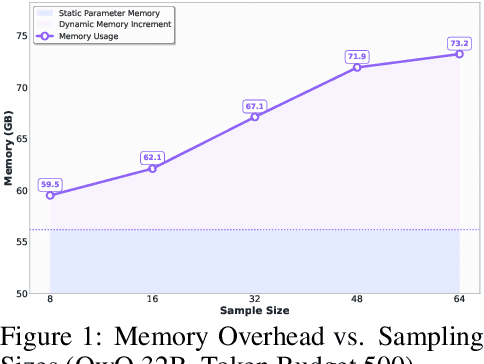
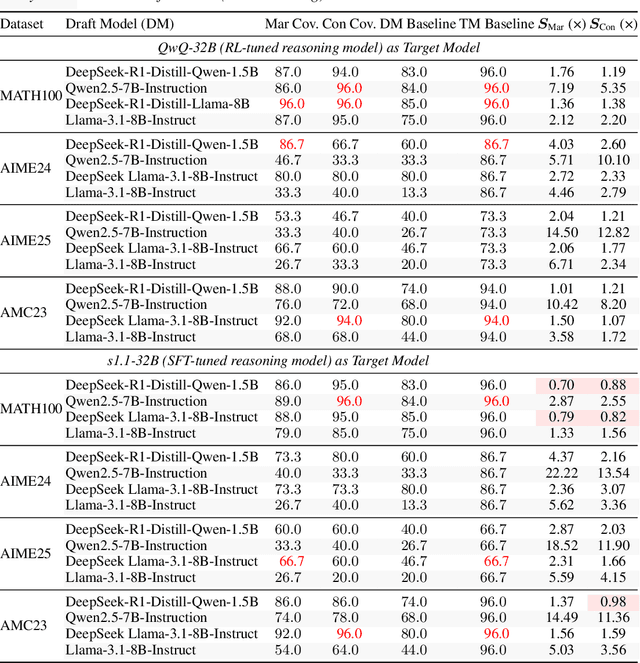

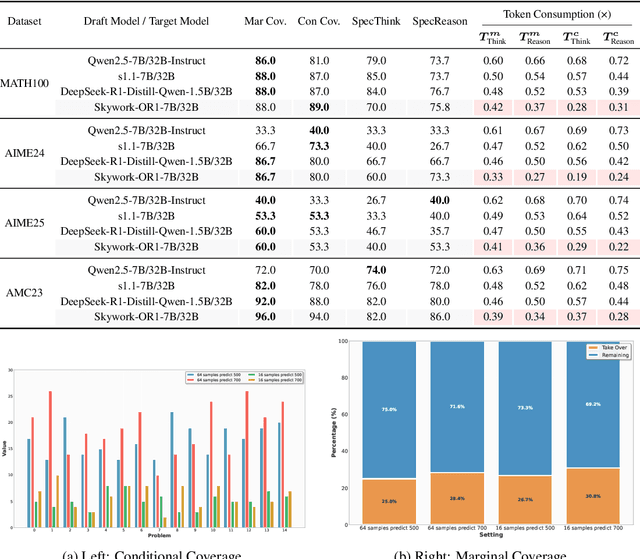
Abstract:Large language models (LLMs) benefit from test-time scaling, but existing methods face significant challenges, including severe synchronization overhead, memory bottlenecks, and latency, especially during speculative decoding with long reasoning chains. We introduce A1 (Asynchronous Test-Time Scaling), a statistically guaranteed adaptive inference framework that addresses these challenges. A1 refines arithmetic intensity to identify synchronization as the dominant bottleneck, proposes an online calibration strategy to enable asynchronous inference, and designs a three-stage rejection sampling pipeline that supports both sequential and parallel scaling. Through experiments on the MATH, AMC23, AIME24, and AIME25 datasets, across various draft-target model families, we demonstrate that A1 achieves a remarkable 56.7x speedup in test-time scaling and a 4.14x improvement in throughput, all while maintaining accurate rejection-rate control, reducing latency and memory overhead, and no accuracy loss compared to using target model scaling alone. These results position A1 as an efficient and principled solution for scalable LLM inference. We have released the code at https://github.com/menik1126/asynchronous-test-time-scaling.
LongEmotion: Measuring Emotional Intelligence of Large Language Models in Long-Context Interaction
Sep 09, 2025

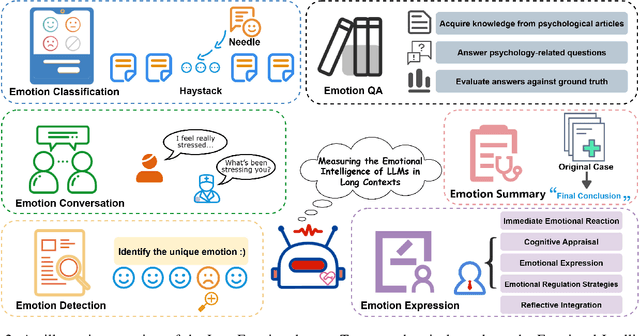
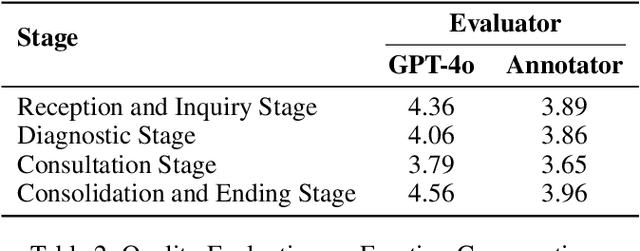
Abstract:Large language models (LLMs) make significant progress in Emotional Intelligence (EI) and long-context understanding. However, existing benchmarks tend to overlook certain aspects of EI in long-context scenarios, especially under realistic, practical settings where interactions are lengthy, diverse, and often noisy. To move towards such realistic settings, we present LongEmotion, a benchmark specifically designed for long-context EI tasks. It covers a diverse set of tasks, including Emotion Classification, Emotion Detection, Emotion QA, Emotion Conversation, Emotion Summary, and Emotion Expression. On average, the input length for these tasks reaches 8,777 tokens, with long-form generation required for Emotion Expression. To enhance performance under realistic constraints, we incorporate Retrieval-Augmented Generation (RAG) and Collaborative Emotional Modeling (CoEM), and compare them with standard prompt-based methods. Unlike conventional approaches, our RAG method leverages both the conversation context and the large language model itself as retrieval sources, avoiding reliance on external knowledge bases. The CoEM method further improves performance by decomposing the task into five stages, integrating both retrieval augmentation and limited knowledge injection. Experimental results show that both RAG and CoEM consistently enhance EI-related performance across most long-context tasks, advancing LLMs toward more practical and real-world EI applications. Furthermore, we conducted a comparative case study experiment on the GPT series to demonstrate the differences among various models in terms of EI. Code is available on GitHub at https://github.com/LongEmotion/LongEmotion, and the project page can be found at https://longemotion.github.io/.
DiffuCoder: Understanding and Improving Masked Diffusion Models for Code Generation
Jun 26, 2025Abstract:Diffusion large language models (dLLMs) are compelling alternatives to autoregressive (AR) models because their denoising models operate over the entire sequence. The global planning and iterative refinement features of dLLMs are particularly useful for code generation. However, current training and inference mechanisms for dLLMs in coding are still under-explored. To demystify the decoding behavior of dLLMs and unlock their potential for coding, we systematically investigate their denoising processes and reinforcement learning (RL) methods. We train a 7B dLLM, \textbf{DiffuCoder}, on 130B tokens of code. Using this model as a testbed, we analyze its decoding behavior, revealing how it differs from that of AR models: (1) dLLMs can decide how causal their generation should be without relying on semi-AR decoding, and (2) increasing the sampling temperature diversifies not only token choices but also their generation order. This diversity creates a rich search space for RL rollouts. For RL training, to reduce the variance of token log-likelihood estimates and maintain training efficiency, we propose \textbf{coupled-GRPO}, a novel sampling scheme that constructs complementary mask noise for completions used in training. In our experiments, coupled-GRPO significantly improves DiffuCoder's performance on code generation benchmarks (+4.4\% on EvalPlus) and reduces reliance on AR bias during decoding. Our work provides deeper insight into the machinery of dLLM generation and offers an effective, diffusion-native RL training framework. https://github.com/apple/ml-diffucoder.
SwingArena: Competitive Programming Arena for Long-context GitHub Issue Solving
May 29, 2025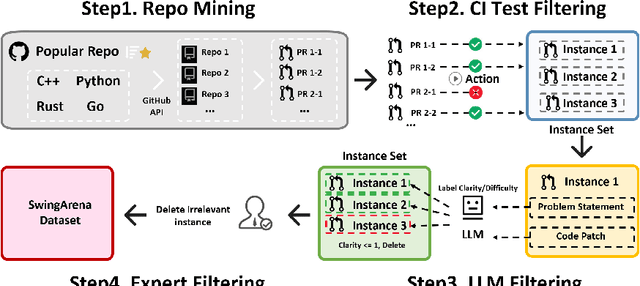
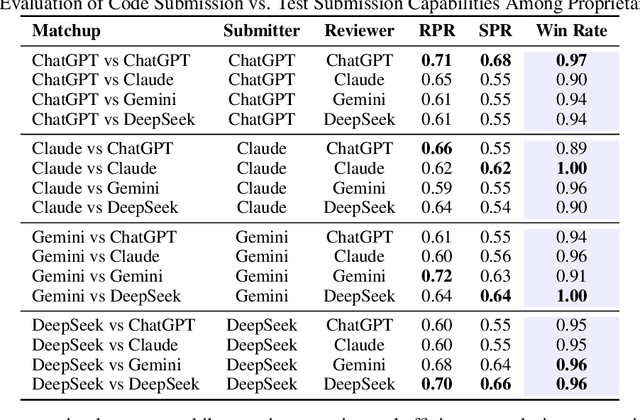
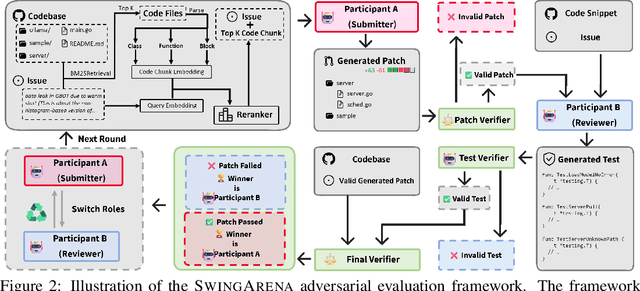

Abstract:We present SwingArena, a competitive evaluation framework for Large Language Models (LLMs) that closely mirrors real-world software development workflows. Unlike traditional static benchmarks, SwingArena models the collaborative process of software iteration by pairing LLMs as submitters, who generate patches, and reviewers, who create test cases and verify the patches through continuous integration (CI) pipelines. To support these interactive evaluations, we introduce a retrieval-augmented code generation (RACG) module that efficiently handles long-context challenges by providing syntactically and semantically relevant code snippets from large codebases, supporting multiple programming languages (C++, Python, Rust, and Go). This enables the framework to scale across diverse tasks and contexts while respecting token limitations. Our experiments, using over 400 high-quality real-world GitHub issues selected from a pool of 2,300 issues, show that models like GPT-4o excel at aggressive patch generation, whereas DeepSeek and Gemini prioritize correctness in CI validation. SwingArena presents a scalable and extensible methodology for evaluating LLMs in realistic, CI-driven software development settings. More details are available on our project page: swing-bench.github.io
Scaling Reasoning without Attention
May 28, 2025Abstract:Large language models (LLMs) have made significant advances in complex reasoning tasks, yet they remain bottlenecked by two core challenges: architectural inefficiency due to reliance on Transformers, and a lack of structured fine-tuning for high-difficulty domains. We introduce \ourmodel, an attention-free language model that addresses both issues through architectural and data-centric innovations. Built on the state space dual (SSD) layers of Mamba-2, our model eliminates the need for self-attention and key-value caching, enabling fixed-memory, constant-time inference. To train it for complex reasoning, we propose a two-phase curriculum fine-tuning strategy based on the \textsc{PromptCoT} synthesis paradigm, which generates pedagogically structured problems via abstract concept selection and rationale-guided generation. On benchmark evaluations, \ourmodel-7B outperforms strong Transformer and hybrid models of comparable scale, and even surpasses the much larger Gemma3-27B by 2.6\% on AIME 24, 0.6\% on AIME 25, and 3.0\% on Livecodebench. These results highlight the potential of state space models as efficient and scalable alternatives to attention-based architectures for high-capacity reasoning.
ScienceBoard: Evaluating Multimodal Autonomous Agents in Realistic Scientific Workflows
May 26, 2025



Abstract:Large Language Models (LLMs) have extended their impact beyond Natural Language Processing, substantially fostering the development of interdisciplinary research. Recently, various LLM-based agents have been developed to assist scientific discovery progress across multiple aspects and domains. Among these, computer-using agents, capable of interacting with operating systems as humans do, are paving the way to automated scientific problem-solving and addressing routines in researchers' workflows. Recognizing the transformative potential of these agents, we introduce ScienceBoard, which encompasses two complementary contributions: (i) a realistic, multi-domain environment featuring dynamic and visually rich scientific workflows with integrated professional software, where agents can autonomously interact via different interfaces to accelerate complex research tasks and experiments; and (ii) a challenging benchmark of 169 high-quality, rigorously validated real-world tasks curated by humans, spanning scientific-discovery workflows in domains such as biochemistry, astronomy, and geoinformatics. Extensive evaluations of agents with state-of-the-art backbones (e.g., GPT-4o, Claude 3.7, UI-TARS) show that, despite some promising results, they still fall short of reliably assisting scientists in complex workflows, achieving only a 15% overall success rate. In-depth analysis further provides valuable insights for addressing current agent limitations and more effective design principles, paving the way to build more capable agents for scientific discovery. Our code, environment, and benchmark are at https://qiushisun.github.io/ScienceBoard-Home/.
 Add to Chrome
Add to Chrome Add to Firefox
Add to Firefox Add to Edge
Add to Edge